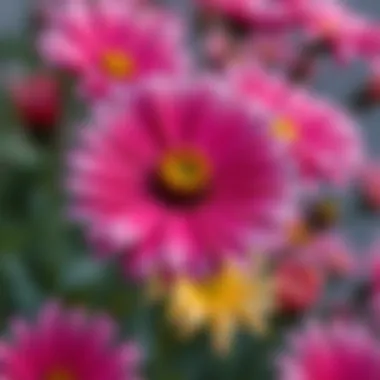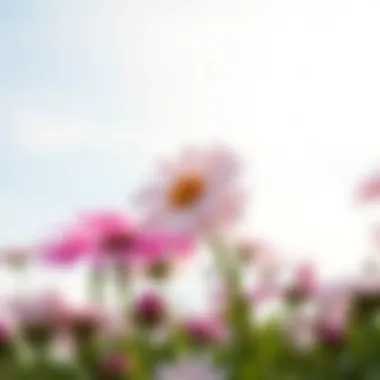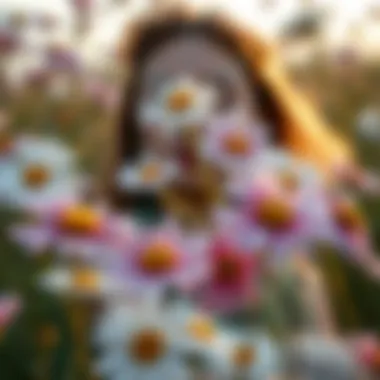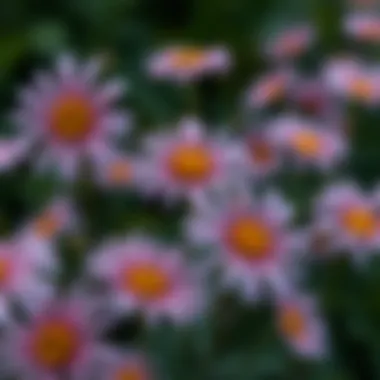Explore the Beauty of Faux Daisies: A Guide


Intro
The allure of faux daisies is undeniable. These lifelike blooms serve as more than mere decorative pieces; they weave through the fabric of fashion and design, holding a unique place in modern aesthetics. Faux daisies find their way into homes, events, and wardrobes, transcending the realms of traditional flower arrangements. Understanding the design and utility of these artificial flowers is crucial for anyone invested in décor or fashion.
With sustainability becoming all the rage, faux daisies present an elegant alternative to their natural counterparts, offering longevity without sacrificing style. Through this guide, readers will delve into the intricate details of these blossoms, learning how to effectively incorporate them into various settings. The multifaceted nature of faux daisies makes them a relevant topic, one that warrants a comprehensive exploration of their characteristics, applications, and evolving trends.
Prelude to Faux Daisies
Faux daisies are more than a mere decorative element; they embody a blend of artistry and practicality. This section is vital as it lays the groundwork for understanding why these artificial blooms have gained traction in various circles, from the home decor enthusiast to fashion-forward designers. The allure of faux daisies is not just in their aesthetic appeal, but also in their ability to evoke feelings associated with natural beauty without the limitations of real flowers.
Definition and Characteristics
Faux daisies are artificial representations of the classic daisy flower, crafted to mimic the look and feel of their real-life counterparts. Made from various materials, these flowers can range from delicately sewn silk to robust polyester or plastic versions. What sets them apart from the real deal is their longevity; unlike fresh daisies, which have a brief lifecycle, faux varieties can maintain their charm year-round. Here are some characteristics that define faux daisies:
- Versatility: Available in a multitude of colors and styles, faux daisies can fit seamlessly into any decor scheme, from rustic cottages to modern minimalist spaces.
- Low Maintenance: No need for watering or sunlight, these blossoms require only occasional dusting. Perfect for busy individuals or those lacking a green thumb.
- Durability: They resist wilting, making them suitable for long-term displays or permanent installations, whether in homes or fashion accessories.
- Customizability: Many manufacturers offer bespoke options, allowing consumers to choose colors, sizes, and arrangements that fit their unique aesthetic preferences.
Historical Context
The fascination with artificial flowers can be traced back centuries. Historically, the use of faux flora was often associated with wealth and elite status, as real flowers were often a luxury that not everyone could afford. Ancient Egyptians adorned their tombs with fabric flowers, while the Japanese art of Ikebana showcases arrangements that sometimes incorporate synthetic materials alongside natural elements. In the modern era, particularly in the 20th century, the rise of synthetic manufacturing technology revolutionized how faux flowers, including daisies, were produced. This advancement allowed for increased realism and accessibility, paving the way for their resurgence in home and fashion alike.
Faux daisies have transformed from mere novelties into staples in both interior design and personal fashion. Their journey reflects broader societal changes about sustainability, style, and personal expression. As the conversation around ecological footprints grows, faux daisies present a compelling alternative—offering beauty without the guilt of environmental impact.
"Artificial flowers have come a long way; they are not just replicas but have become a statement about our aesthetic values and environmental concerns."
In summary, faux daisies present not only a practical bouquet alternative but also a rich tapestry woven into the broader context of art, culture, and sustainability. Understanding how they were shaped by history and their role in current trends enhances our appreciation of their presence in our lives.
Types of Faux Daisies
The diversity in the types of faux daisies plays a crucial role in appreciating and utilizing them effectively. Understanding the specifics of these categories can greatly enhance one's selection process and creative applications. Different materials and designs bring distinct flavors, aesthetics, and functionalities to interiors and fashion. Below, we explore the various materials and designs that shape the landscape of faux daisies.
Materials Used
When it comes to faux daisies, the materials they are made from can make all the difference in quality, appearance, and longevity. Let's take an in-depth look at the most common materials.
Silk
Silk is known for its luxurious texture and vibrant colors, making it a popular choice among faux floral enthusiasts. Its soft and smooth finish gives faux daisies a realistic touch that can be both eye-catching and elegant.
One of the key characteristics of silk is its ability to mimic the delicate petals of natural flowers. This quality not only enhances their visual appeal but also makes them suitable for high-end decor settings. However, silk faux daisies might not fare well in direct sunlight, as prolonged exposure can fade their colors over time.
Advantages of silk include:
- Luxury feel
- Rich colors and textures
- Lightweight and easy to handle
On the downside, they can be more susceptible to dust collection, needing regular upkeep to maintain their appearance.
Polyester
Polyester faux daisies present a versatile alternative that blends quality with affordability. Known for their durability, they can withstand various environmental factors much better than silk. Polyester is resistant to shrinkage and stretching, making these faux flowers a practical option for both indoor and outdoor decor.
The most significant advantage of polyester is its colorfastness, meaning the colors remain vibrant even under harsh conditions. It allows for a broader spectrum of designs, catering to various themes and occasions.
Key aspects of polyester faux daisies include:
- Durable and weather-resistant
- Wide range of designs
- Affordable
However, they may lack the authenticity and luxurious feel that silk provides.
Plastic
Plastic faux daisies capture the essence of convenience. They are often economically priced, making them an attractive option for large decorative displays or even whimsical installations. Plastic is incredibly durable and easy to maintain, which appeals to many customers looking for low-maintenance solutions.
One important feature of plastic flowers is their resilience against weather elements, making them ideal for outdoor use or conditions where other materials might degrade. They can easily be washed and cleaned, ensuring their longevity.
Some noteworthy points about plastic faux daisies are:
- Highly resistant to wear and tear
- Easy to clean and maintain
- Good for budget-conscious buyers


However, they might come off as less elegant compared to their silk counterparts, lacking the softness and realism that silk and polyester offer.
Variations and Designs
Faux daisies come in various designs and styles that cater to diverse tastes and design philosophies. Understanding these variations can aid in making more informed decisions when selecting faux daisies for specific decor aims.
Classic Daisies
Classic daisies are the embodiment of simplicity and charm. They generally replicate the well-loved Marguerite daisy's look, featuring a yellow center surrounded by bright white petals.
This timeless design adds freshness and cheer to any space, making them versatile for both casual and formal settings. Their stark yet simple beauty also allows them to blend harmoniously with various themes and styles, whether rustic or modern.
Key characteristics include:
- Timeless appeal
- Versatile for any decor style
- Minimalistic elegance
However, their simplicity might not suit those looking for something more elaborate or ostentatious.
Novelty Designs
Novelty designs push the envelope by incorporating unique shapes, colors, and patterns that can bring an extra flair to decor. These faux daisies may feature unusual color combinations or imaginative interpretations of traditional designs.
Such designs can act as conversation starters. Their playful aesthetics can easily enhance themed events or casual spaces, appealing to those who favor creativity over traditional decor.
Noteworthy aspects of novelty designs include:
- Creative and playful appeal
- Great for themed occasions
- Potential to make bold statements
However, they may not fit seamlessly into traditional or classically styled interiors.
Custom Creations
Custom creations present an opportunity for individual expression and personalization. Customers can choose specific colors, shapes, and arrangements to create faux daisies that match their unique vision and decor needs.
This option allows for the blending of personal aesthetics with practicality. As a result, they can perfectly align with any event, mood, or interior scheme, making them a highly valuable choice.
Advantages of custom creations include:
- Tailored to personal preferences
- Exclusivity
- Endless design possibilities
On the flip side, custom options tend to be more expensive and may require longer wait times for production, which can be a drawback for some.
In summary, the types of faux daisies, including their materials and designs, significantly shape their role in decorative artistry and functional design. Selecting the right type can enhance aesthetics while aligning with personal or thematic values.
The Role of Faux Daisies in Interior Design
In the realm of interior design, faux daisies hold a notable space, thanks to their versatility and aesthetic charm. These artificial flowers can enhance decor in myriad ways, offering both visual delight and practical benefits. Not only do they cater to a plethora of design styles, but they also present an opportunity for creativity and customization that fresh flowers simply cannot match. The importance of faux daisies lies not just in their appearance, but also in their enduring presence in spaces where fresh blooms might wilt or fade.
One of the greatest advantages of faux daisies is their long-lasting nature. Unlike fresh flowers, which can wilt within days and require constant upkeep, these synthetic alternatives remain vibrant with minimal care. This makes them an ideal choice for busy households or corporate settings where maintaining live plants can be a daunting task.
Aesthetics and Decor
When it comes to aesthetics, faux daisies serve as a timeless decor element that embodies freshness and liveliness. Their bright colors and cheerful shapes bring a sense of warmth to any environment. They can be used in various ways:
- Table centerpieces: Clustered together, faux daisies can create stunning focal points that capture attention without overshadowing the main elements of a design.
- Wall arrangements: Aesthetic wall hangings featuring faux daisies bring a burst of color to otherwise bland spaces, transforming a plain wall into an artful display.
- Decorative vases: Placing faux daisies in decorative vases can enhance the look of a room while adding layers of texture and contrast.
The beauty of using faux daisies in decor is that they suit any season or occasion. They can easily blend in with different styles—be it vintage, contemporary, or rustic—without feeling out of place.
Seasonal and Thematic Integrations
Spring and Summer Themes
Faux daisies offer a perfect fit for spring and summer themes that seek to harness nature’s beauty. Their bright, sunny disposition symbolizes warmth and growth, making them particularly beneficial during these seasons. For designers and homeowners, faux daisies enhance the ambiance and give life to indoor spaces, reminiscent of blooming gardens outside.
- Charge up spaces: Incorporating faux daisies can energize a room, evoking feelings of bliss and rejuvenation.
- Versatile arrangements: From simple bouquets to elaborate arrangements, they add a splash of color that complements other summer elements like citrus hues or pastel shades.
However, designers should be mindful to not overdo it—too many faux daisies might lead to a cluttered appearance. Moderation is key to harnessing their benefits.
Holidays and Celebrations


Faux daisies find a special place during various holidays and celebrations. They can be utilized to commemorate events like graduations, weddings, and birthday parties, providing a cheerful backdrop to special moments.
- Decorative flexibility: They can adapt to various themes, such as bright and playful for a child’s birthday or elegant and subtle for a wedding.
- Cost-effective solutions: Since faux daisies can be reused, they serve as a wallet-friendly option for seasonal decor that can last year after year.
While the ease of use and functional aspects are appealing, it’s crucial to select colors and styles that resonate with each specific occasion. Striking the right balance can ensure that faux daisies enhance rather than distract from the festive spirit.
Faux daisies inject a touch of charm in both everyday settings and special occasions, offering a practical yet stylish way to elevate any room's design.
Faux Daisies in Fashion Accessories
Faux daisies have made quite an impact in the realm of fashion accessories, offering a blend of beauty and practicality to a variety of designs. Not only do these artificial blooms serve as charming adornments, but they also appeal to those seeking durable, low-maintenance alternatives to real flowers. Their versatility allows for integration in multiple aspects of fashion, enabling designers and fashion enthusiasts alike to express creativity without the constraints of seasonality inherent to real flowers.
Jewelry Incorporation
The incorporation of faux daisies into jewelry is a trend that resonates with both personal style and sentiment. From necklaces to earrings, these artificial flowers can add a delicate touch that emphasizes the wearer's unique aesthetic. The charm of faux daisies in jewelry lies in their ability to emulate the natural beauty of daisies without wilting or fading over time. This means individuals can wear their favorite floral designs with confidence, knowing they can stand the test of time.
Additionally, faux daisies can be made in various colors and styles, allowing for customization that suits different moods and occasions. Whether it's a casual day out or a fancy evening gathering, faux daisy jewelry can be an eye-catching accessory that complements various outfits without overshadowing them.
Textile Applications
Incorporating faux daisies into textiles breathes life into garments and accessories. Beyond mere decoration, these floral embellishments possess an innate charm that transforms simple clothing into fashion statements.
Embellishments on Garments
Embellishments on garments featuring faux daisies offer a unique aesthetic, contributing to a garment's overall appeal and character. These additions can range from subtle embroidery on sleeves to larger appliques near the hemline. The key characteristic of such embellishments is their ability to evoke a feeling of freshness and femininity. This makes them a favored choice among designers looking to add a personal touch to their collections.
One unique feature of using faux daisies as embellishments is their adaptability. Unlike fresh flowers, which may not hold up during washing or movement, faux daisies retain their appearance under various conditions. However, while these embellishments can enhance visual appeal, one should consider the balance of design; sometimes, less is more to avoid overwhelming the piece.
Faux Daisies in Bags and Shoes
Faux daisies in bags and shoes represent another practical application within fashion. Designed to maintain visual impact while reinforcing the durability of these items, they allow creators to develop products that are as stylish as they are functional. The key characteristic of adding faux daisies to these accessories is to create a playful touch, perfect for spring and summer collections.
Their unique feature often lies in the careful craftsmanship that ensures these embellishments look vibrant and fresh. Faux daisies can often withstand the wear and tear of everyday use, presenting one of their significant advantages. However, it is important to consider that not all faux flower applications can blend seamlessly with every design; some may appear somewhat contrived if not thoughtfully integrated.
In the ever-evolving realm of fashion, faux daisies serve as a bridge between nature’s elegance and the needs of modern-style enthusiasts.
Practical Considerations When Choosing Faux Daisies
Choosing faux daisies may seem straightforward, yet navigating the options can be a bit of a minefield. With various quality levels and price points, it's vital to discern what makes a faux daisy worth your investment. Whether it's for decorating a home or crafting a unique fashion accessory, understanding the practical aspects can save buyers from a heap of regret.
Quality Indicators
When considering faux daisies, one cannot undervalue the importance of quality indicators. Just like any product, not all faux flowers are created equal. Here are some key indicators to keep an eye on:
- Material Composition: Opt for daisies made from high-grade materials. Silk gives a soft touch that mimics real petals effectively, while well-made polyester can be equally durable.
- Realism: Take a close look. High-quality faux daisies often feature intricate details like delicate veins and subtle shading. The petals should feel lifelike and the colors should reflect what you’d find in nature.
- Construction: Examine how the flowers are constructed. Look for sturdy stems and secure attachments of petals. A daisy that retains its shape under a little pressure is likely built to last.
"Quality in faux daisies not only enhances aesthetic appeal but can elevate the entire decor or fashion ensemble."
Cost vs. Value
Next, let’s delve into the tension between cost and value. It’s easy to gravitate towards the cheapest option, especially when tempting deals pop up. However, one must consider:
- Long-term Investment: Often, investing in higher-quality faux daisies pays off. Cheaper materials might fade or lose their shape, requiring replacement sooner than expected. Think of it like buying a good mattress; upfront cost might be higher, but it’s worth it down the line.
- Usability: If your faux daisies are for frequent use in a collection of displays, investing in durable petals makes sense. Fragile flowers won’t withstand wear and tear.
- Aesthetic Impact: Quality faux daisies can transform a space. When selected thoughtfully, they provide charm and elegance that can elevate even the plainest of surroundings.
Ultimately, understanding the interplay between quality and cost is fundamental. Faux daisies embody an art form, where the right choices lead to stunning visual impact without the upkeep of real flowers. Knowing what you value most will guide you in making a wise purchase.
Maintenance of Faux Daisies
The maintenance of faux daisies is a significant aspect that often gets overshadowed by their aesthetic appeal and creative applications. While these artificial flowers serve a notable purpose in decor and fashion, understanding how to care for them can drastically extend their lifespan and ensure they consistently look their best. Let's explore why maintenance matters and how you can effectively care for your faux daisies, ensuring these charming blooms remain a vibrant addition to your environment.
Cleaning Techniques
Dust and dirt can be the unwelcome guests that make even the most elegant faux daisies appear lackluster. A thorough cleaning process is essential for maintaining their crisp appearance.
- Gentle Dusting: For regular upkeep, using a soft, dry cloth or a feather duster can effectively remove dust. This simple technique prevents buildup without damaging the materials. It's akin to brushing off the cobwebs from a cherished hat – you can't deny it makes a difference.
- Soapy Water Cleanup: If faux daisies require a bit more attention, a mixture of lukewarm water and mild soap should do the trick. Dip a cloth in the solution, wring it out well, and gently wipe the petals and leaves. Avoid soaking them, since excess moisture may lead to irreversible damage.
- Use of Compressed Air: For intricate designs or those hard-to-reach areas, using a can of compressed air can blow away stubborn particles. Just remember to keep the nozzle a safe distance away to avoid causing any harm.
"Prevention is better than cure," a wise saying that rings true even for faux daisies. Regular cleaning can save you from extensive restoration efforts later.


Storage Recommendations
Proper storage is another crucial component in the care of faux daisies. How you choose to store them can influence both their appearance and durability.
- Temperature and Environment: Floral arrangements should ideally be kept in a cool, dry place. Excessive heat and humidity can lead to materials degrading over time, transforming vibrant blossoms into pale shadows of their former selves.
- Avoiding Overcrowding: Storing faux daisies with other items can cause them to become tangled or crushed. It is advisable to separate them or store them in their own designated area. Using a box or a container with tissue paper can prevent damage.
- Standing or Hanging Storage: For larger arrangements, consider a vertical position for storing. You can use a flower keeper or even hang them in a closet. This not only saves space but also maintains their shape, much like hanging a well-tailored garment.
Incorporating these simple yet effective maintenance techniques can significantly enhance the longevity of faux daisies. Considering their environmentally friendly nature and aesthetic contributions, it’s worth taking the time to ensure they don’t lose their charm but rather continue to brighten up your space for seasons to come.
The Environmental Impact of Faux Daisies
The introduction of faux daisies into the decorative and fashion industries raises important discussions about their environmental footprint. While they provide aesthetic appeal without the upkeep that real flowers demand, they also prompt a closer examination of the materials used, the lifecycle of these products, and their contribution to sustainability efforts. This section navigates through the key elements surrounding the environmental impact of faux daisies, offering insights that can help both consumers and designers make informed decisions.
Sustainable Choices
When it comes to faux daisies, the materials they are made from play a significant role in their overall environmental footprint. Here are a few sustainable choices to consider:
- Material Selection: Opting for faux daisies made with sustainably sourced materials can reduce the ecological impact. For instance, some manufacturers are shifting towards biodegradable plastics or recycled materials. This means less dependency on petroleum products, thus minimizing contribution to fossil fuel depletion.
- Local Sourcing: Supporting brands that produce faux flowers locally can reduce emissions associated with transportation. Choosing products that are produced nearby not only helps the local economy but is also more environmentally friendly.
- Durability and Longevity: High-quality faux daisies tend to last longer than their cheaper counterparts. If a product is made to endure over time, it cuts down on the waste generated from everyday disposables. Investing in quality can often mean fewer replacements down the line, translating to less waste and resource consumption overall.
Choosing eco-conscious faux daisies makes sense not just for the planet but also for modern consumers who are increasingly mindful of their purchase decisions.
Comparative Analysis with Real Flowers
When comparing faux daisies to their natural counterparts, it's essential to weigh the pros and cons of each in terms of environmental impact. Here are some comparative points:
- Water Usage: Real flowers require significant amounts of water and, in many regions, contribute to over-extraction of local water resources. Faux daisies, by contrast, do not demand such resources to thrive, hence their ecological impact can be considerably lower in this aspect.
- Waste: Real flowers, while beautiful, are often discarded shortly after their display due to wilting. This leads to substantial organic waste in landfills. In contrast, faux flowers can be reused for many seasons, significantly diminishing long-term waste.
- Pesticide and Fertilizer Use: The cultivation of real flowers necessitates various chemicals that can be harmful to the environment. Faux daisies eliminate this concern altogether.
"The decision to use faux flowers does not solely stem from aesthetic preferences; it reflects a growing awareness of sustainable alternatives in our daily choices."
By juxtaposing faux daisies against real flowers, it becomes easier to appreciate the environmental benefits that faux varieties can bring to home decor, fashion, and beyond. Ultimately, whether one prefers the simplicity of faux or the allure of real, understanding the underlying environmental implications can lead to more conscious consumer behavior.
Trends in Faux Daisies
Faux daisies are not just a decorative afterthought; they have emerged as a significant trend within the world of design and fashion. As sustainability and aesthetic preferences evolve, faux daisies adapt to fit into contemporary trends that appeal to fashion enthusiasts, retailers, and interior designers alike. This section dives into the importance of tracking these trends, focusing on emerging styles and cultural influences that shape their applications. Being aware of these aspects enhances one’s decision-making when choosing faux daisies, ensuring that selections align with both personal taste and broader design currents.
Emerging Styles
The styles of faux daisies are evolving just as rapidly as those of their fresh counterparts. From minimalist aesthetics to bohemian vibes, emerging styles of faux daisies showcase various design philosophies. A few prominent styles include:
- Whimsical Designs: These faux daisies feature bright colors and exaggerated proportions. Designers are introducing unique shapes and combinations that cater to a youthful crowd, aiming to bring vibrancy into everyday spaces or fashion pieces.
- Minimalist Aesthetic: This trend sees faux daisies produced in neutral tones and understated designs. These blooms can seamlessly integrate into a sleek, modern environment, resonating with those who lean towards simplicity and cleanliness in decor.
- Vintage and Retro Touches: There is a resurgence of interest in vintage styles where faux daisies mimic the appearance of blooms from decades past. This lends a nostalgic feel to design elements, allowing for rich textural contrasts between old and new, which appeals to an audience that appreciates design history.
- Realistic Reproductions: Emerging technologies are creating faux daisies that closely resemble real flowers, including intricate details like variances in petal touches and leaf designs. This style caters to those who desire the beauty of fresh flowers without the associated maintenance.
Understanding these styles helps consumers and designers navigate the expansive world of faux daisies, enabling them to select options that resonate with current trends.
Cultural Influences
The appeal of faux daisies goes beyond mere aesthetics; these artificial blooms also reflect deeper cultural trends and values. Several cultural influences are currently shaping the use of faux daisies in various contexts:
- Sustainability Movement: As environmental consciousness rises, many are opting for faux daisies to reduce their ecological footprint. Using sustainable materials in the production of faux flowers addresses consumer concerns while still delivering beauty and vibrancy to any setting.
- Social Media and Influencer Culture: Platforms like Instagram and Pinterest have amplified trends, showcasing how faux daisies can transform spaces with their versatility. Influencers often highlight unique ways to integrate faux flowers into decor, sparking interest and inspiring followers to incorporate them into their own lives.
- Cultural Celebrations and Events: Faux daisies are often adopted in cultural festivals due to their durability and the ease of styling. Events like weddings and seasonal festivals increasingly feature faux daisies, offering charm while addressing potential logistical challenges—having to manage wilting flowers.
- Globalization of Design Trends: As styles cross borders, faux daisies are inspired by diverse cultural aesthetics, leading to unique design outcomes. For example, blending Eastern floral artistry with Western design principles offers a fresh take, making faux daisies adaptable to a wider range of cultural themes.
These emerging styles and cultural influences illustrate how the faux daisy landscape is rich and filled with potential for new applications, offering design solutions that cater to the ever-evolving tastes of contemporary society.
In the world of design, staying informed about trends is not just advantageous; it’s essential. Faux daisies are in many ways a mirror reflecting larger societal shifts.
By understanding these elements, designers and stylists can capitalize on recent developments and contribute to a broader dialogue about aesthetic preferences and sustainable practices.
For further exploration of design influences and trends, you might find interesting insights on platforms like Wikipedia, Britannica, and community discussions on Reddit.
Epilogue
In wrapping up our exploration of faux daisies, it becomes evident that these artificial blooms embody not just utility but also a blend of artistry and sustainability. Their importance transcends mere decor—faux daisies offer an array of functional benefits while serving as a canvas for creative expression. As we dissect the roles these flowers play in both interior design and fashion, we recognize their versatility, making them a staple in many households and wardrobes.
Recap of Faux Daisies’ Importance
Faux daisies are significant for several reasons:
- Aesthetic Appeal: These flowers bring life and color to any setting without the worry of wilting or significant maintenance. They can brighten up dull corners, making them perfect for various design themes.
- Durability: Unlike fresh flowers, faux daisies withstand time. They remain vibrant, allowing both casual and formal displays with consistent beauty throughout the seasons.
- Cost-Effectiveness: Investing in faux flowers often proves economical in the long run. No repeated purchases are needed for seasonal decorations, enabling you to save money while still achieving stunning aesthetics.
- Sustainability Factors: In an age where sustainability is paramount, faux daisies present an eco-friendly alternative to real blooms, especially when sourced from environmentally conscious manufacturers. They continue to be an attractive option for eco-minded individuals.
To emphasize their significance, consider this:
"Faux daisies are not merely imitations; they serve as testaments to human ingenuity and our desire to bring nature indoors without the drawbacks of living plants."
Future Directions
As we look toward the future, several trends regarding faux daisies are emerging.
- Sustainable Practices: The push for eco-friendly production methods is making its way into the faux flower industry. Manufacturers are increasingly opting for recycled materials, highlighting a commitment to sustainable design practices.
- Customization: There is growing market demand for personalized faux daisies. Custom designs that reflect individual styles or seasonal themes are likely to gain traction, making these blooms not only décor elements but also expressions of identity.
- Technological Integration: Advances in technology may lead to even more realistic designs and textures. Innovations could create lifelike blooms that could rival their natural counterparts, allowing for enhanced visual appeal and consumer engagement.



